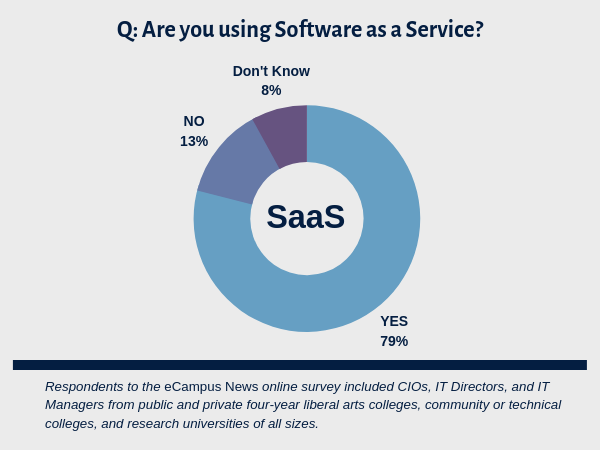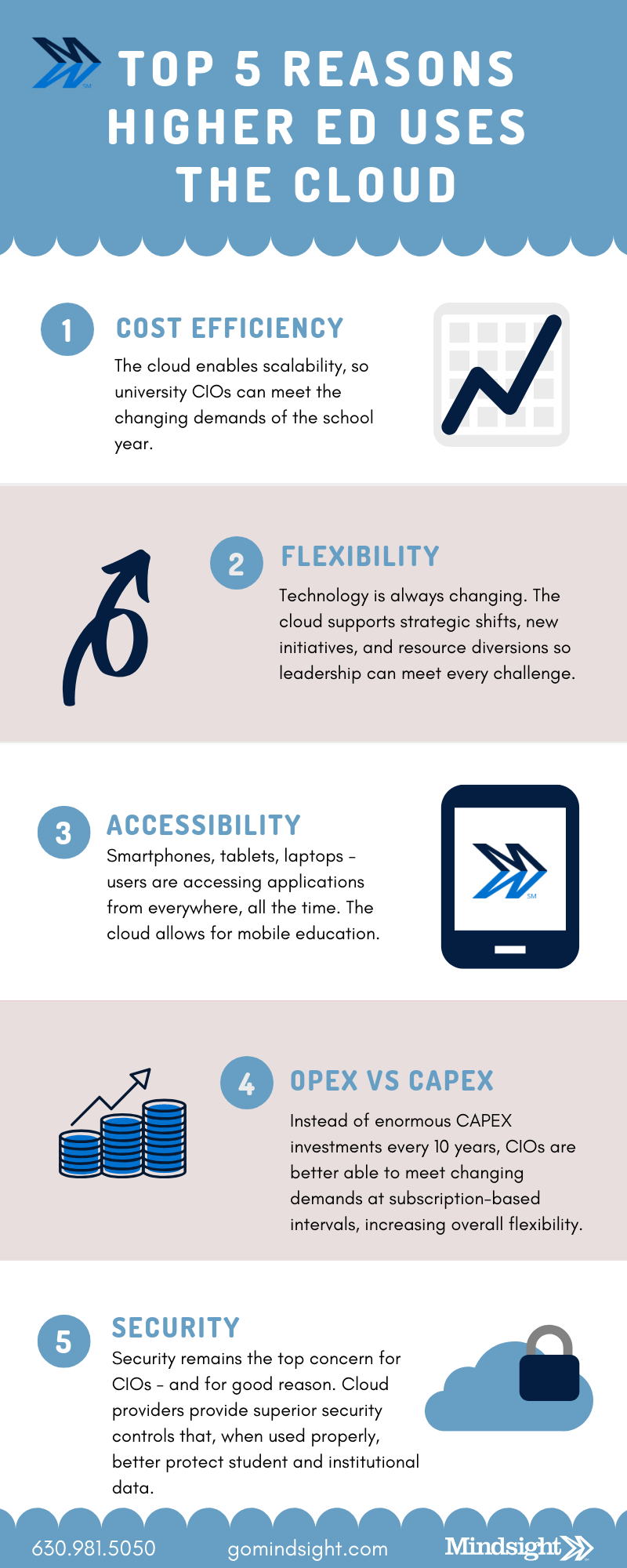September 3, 2019 by Siobhan ClimerandMike Czerniak
A recent study by eCampus News found that higher education chief information officers (CIOs) are using the cloud to manage a wide range of technology for almost every aspect of the institution, from administrative tasks to student learning, basic services to innovative applications.
Software-as-a-service (SaaS) applications take the lead and cover email, learning management systems, and productivity tools. In fact, 79% of respondents reported using SaaS today.
The cloud is changing how students access learning, how professors teach, and how everyone from the part-time intern to the president access, share, and use applications for institutional operations.

Why Is Cloud Transformative?
Cost efficiency
Cost efficiency is the leading driver of cloud adoption in higher education, not cost savings. Cloud technology enables increased scalability. This is especially useful to higher education institutions, since they experience dramatic shifts in use during the course of the year.
Consider class registration periods versus summer holidays. Big difference.
These peaks and troughs create problems on traditional infrastructure. By operating in the cloud, CIOs engage the scalability benefits of the cloud in higher education to benefit all users.
This has long-term cost efficiency benefits: a fully-operational technology portfolio draws in new students, improves academic outcomes, and leads to greater revenue for the institution.
While cost-efficiencies are the biggest driver of cloud adoption, the eCampus report, as well as research by Educause and Huron, found several other factors that are leading CIOs to leverage the cloud in higher education.
Find out how you can optimize the cloud for your institution with a FREE whiteboard chat with our cloud design and deployment experts.
Flexibility
Traditional data center infrastructure, hardware, and legacy IT systems are costly to maintain. Upgrades are expensive. Plus, the applications put in place today would likely be obsolete within a year.
The cloud gives CIOs the flexibility to divert resources, shift strategy, and keep up-to-date with the mutable nature of technology. This benefits students, professors, and administrators.
Accessibility
 Unlike the college of ten years ago, students are no longer relegated to computer labs or library desktop computers.
Unlike the college of ten years ago, students are no longer relegated to computer labs or library desktop computers.
Professors conduct virtual classes. Administrators are not only tracking and recording information but using the data to generate revenue and opportunity for the institution. Students are logging onto the network via a multitude of devices from both on- and off-campus locations.
The cloud is key to this mobility. By providing broad network access anywhere, anytime, the cloud enables improved collaboration and learning.
OPEX vs CAPEX
For too long, the role of IT in any institution was seen as a “cost center”, as new servers, routers, data centers, switches, and other CAPEX expenditures took big bites from budgets.
CIOs looking at the cloud in higher education recognize that it enables them to offload this enormous up-front cost to better meet the current and capricious needs of the institution. These costs are transferred to an OPEX model, which better suits the fluctuations common in higher education institutions.
Security
Security remains a leading concern for technology leaders in higher education (68% of the eCampus News respondents listed it as the top challenge with cloud computing). Yet, institutions with the most to lose – large, private four year universities – are those most likely to adopt the cloud.
Why?
“Most cloud providers probably have better security controls than most companies,” says Zeus Kerravala, founder of ZK Research.
Public cloud providers offer cloud services to all sorts of organizations, including those that have incredibly high security requirements – like the Department of Defense (DoD), Boeing, and the National Oceanic and Atmospheric Administration (NOAA). They all use the cloud in one way or another for functional operability.
That’s why cloud adoption for large organizations, like universities, is so high. Protecting data is key to technology leadership. The key to utilizing cloud-based security controls is understanding how the shared responsibility model impacts CIOs and CISOs.
How Cloud In Higher Education Leads To Change
Technology is always changing. That’s the Mindsight mantra. Community colleges, trade schools, two and four year universities – these are the institutions preparing the leaders and thinkers of tomorrow.
Higher education needs to be at the cutting edge of everything: research, innovation, and technology so graduates are prepared for the world as it stands, so they can build on it and make it better.
The cloud is still considered one of the most disruptive technologies, and it upends traditional ideas of network architecture, security controls, and access. For institutions of higher education, the cloud provides an opportunity to reduce overall risk and better serve users.
Our experts can step on-site for a two-hour dive into your infrastructure – identifying what you have, where, and why – and hand-deliver you a Cloud Insights Report. The report includes the five next steps you can take to maximize your on-premise and cloud infrastructure for the world of tomorrow.
Like what you read?
Contact us today to discuss how to leverage the cloud in higher education.
About Mindsight
Mindsight, a Chicago IT services provider, is an extension of your team. Our culture is built on transparency and trust, and our team is made up of extraordinary people – the kinds of people you would hire. We have one of the largest expert-level engineering teams delivering the full spectrum of IT services and solutions, from cloud to infrastructure, collaboration to contact center. Our customers rely on our thought leadership, responsiveness, and dedication to solving their toughest technology challenges.
Contact us at GoMindsight.com.
About The Authors
Mike Czerniak is the Cloud Practice Manager at Mindsight, an IT Services and Consulting firm located in the Chicago area. With 20 years of experience in information technology and the cloud, Mike has helped hundreds of organizations with architecting, implementing, and deploying cloud solutions. For the last 5 years, Mike has focused on providing Mindsight’s customers with guidance in approaching – and managing – the cloud. Mike is AWS, Microsoft Azure, VMware certified, and remains deeply invested in providing an agnostic, consultative voice for organizations on their cloud journey. In his free time, Mike enjoys biking with his 9-year old son, recently completing a 50-mile bike ride!
Siobhan Climer, Science and Technology Writer for Mindsight, writes about technology trends in education, healthcare, and business. She writes extensively about cybersecurity, disaster recovery, cloud services, backups, data storage, network infrastructure, and the contact center. When she’s not writing tech, she’s reading and writing fantasy, gardening, and exploring the world with her twin daughters. Find her on twitter @techtalksio.
Protect K-12 Student Users In The Cloud: Cisco’s CloudLock And Umbrella Combo




